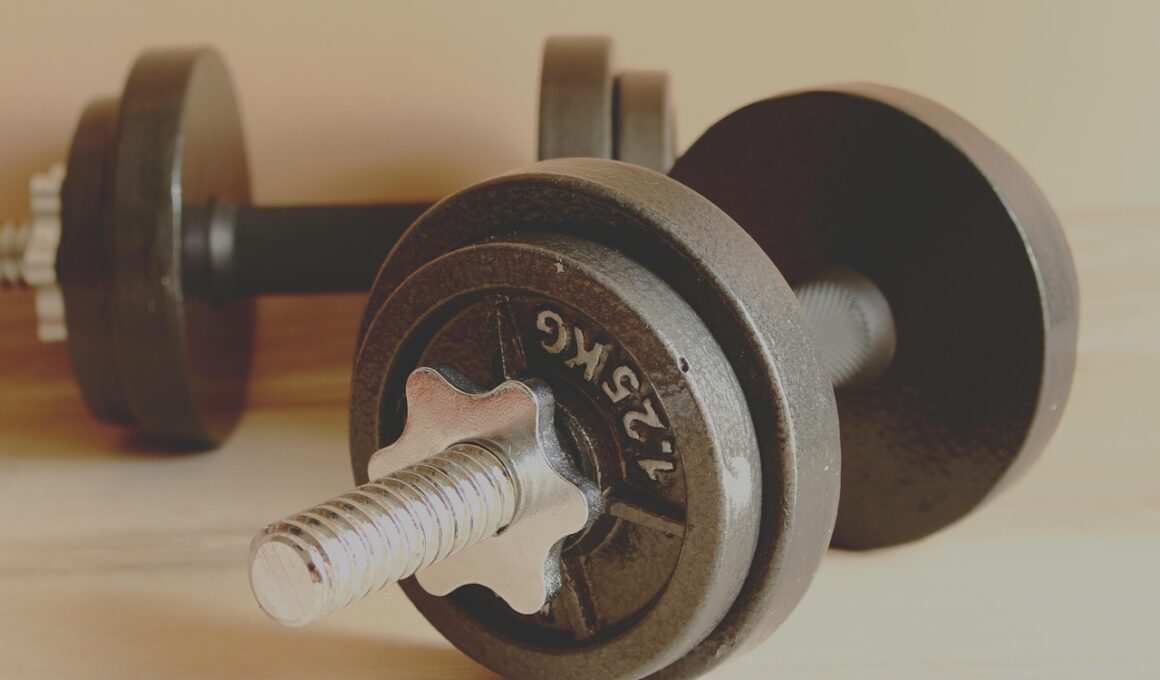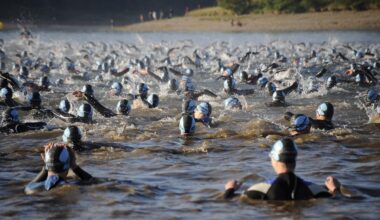Tips for Improving Your Weightlifting Technique
Weightlifting techniques can significantly influence performance, enhancing strength and agility. To improve your weightlifting technique, focus on posture and body alignment. A strong foundation is critical. Begin with your feet shoulder-width apart, ensuring a balanced stance. Engage your core, which is essential for stability. Proper breathing enhances performance; inhale during the eccentric phase and exhale during the concentric phase. Maintain a neutral spine throughout the lift, which reduces the risk of injury. Warm-up exercises, such as light cardio, prepare your muscles for lifting by increasing blood flow and flexibility, preventing injuries. Utilize dynamic stretches focusing on muscle groups involved in weightlifting. Always have a spotter present during your workouts; they’ll provide safety during heavy lifts. Choose the right equipment, including quality shoes with proper grip. Performing various exercises, like deadlifts or squats, allows your body to adapt to different movements, enhancing overall performance. Seek professional guidance if possible; trainers can provide tailored advice. Video analysis can also be useful; recording your lifts lets you identify flaws and improve techniques. Stay consistent, as frequent practice yields the best results, and soon you’ll master your weightlifting technique.
Feedback is crucial to refining your weightlifting technique. Understanding how your body responds to various lifts allows you to make adjustments effectively. Utilize light weights during practice to focus on form. Slow down your movements, emphasizing controlled repetition, which can help engrain the correct posture. Gradually increase the weight only when you’re confident in your technique. Incorporate flexibility training into your routine, as increased flexibility can enhance lifting capabilities, particularly for squats and deadlifts. Exercises focusing on hip and shoulder mobility can contribute significantly to better lifting technique. Nutrition also plays a vital role; consume a balanced diet rich in protein, which supports muscle recovery and growth. Staying hydrated is equally important as it enhances performance. Track your progress; keep a detailed record of your lifts, reflecting on what works best for you. This also helps in setting realistic goals. Joining a weightlifting community can provide additional support and motivation. Engaging with others can enhance your learning process. Remember, consistent practice combined with the tips mentioned can lead to substantial improvements in your weightlifting techniques.
Common Mistakes in Weightlifting
Recognizing common mistakes is vital for improving your weightlifting technique. One frequent error is lifting weights that are too heavy too soon, leading to improper form and potentially injury. Avoid this by mastering lower weights first. Another mistake is neglecting the importance of warm-ups; proper warm-ups prevent injuries and enhance performance. Skipping them may lead to muscle strains and decreased flexibility. Moreover, don’t forget to engage your core, as many lifters often overlook this critical component, which is essential for maintaining balance and preventing back injuries. Additionally, poor grip can hinder performance; ensure that you grip the bar correctly to control the weight adequately. Failure to breathe correctly is another mistake; remember to inhale during the lowering phase and exhale during the lift for optimal performance. A lack of rest days can also impede progress; muscle recovery is vital for strength gains. Finally, avoid comparing yourself to others in the gym; focus on your personal journey. Tracking your own improvements makes the process more enjoyable and keeps motivation high. Correcting these mistakes can greatly enhance your overall weightlifting experience.
Another critical aspect is the role of proper nutrition within your weightlifting routine. Adequate nutrition fuels your body and aids recovery, contributing to more effective and longer-lasting workouts. Ensure that you consume a balanced ratio of macronutrients, including carbohydrates, proteins, and fats. Carbohydrates provide the necessary energy before workouts, while proteins are essential for muscle repair and growth post-exercise. Timing is also crucial; consuming a protein-rich meal after lifting helps muscles recover faster. It’s beneficial to snack on protein bars or shakes if you cannot have a full meal immediately after. Hydration is an often neglected part of nutrition; being well-hydrated supports peak performance levels during lifts. Consider electrolyte-rich beverages if you’re lifting intensely for extended periods. Paying attention to micronutrients like vitamins and minerals supports overall health, ensuring all bodily functions operate optimally. Incorporating a variety of foods in your diet can help in achieving this. Experiment with different meals and supplements to find what works best for your body and workout regime. Understanding your nutritional needs can remarkably enhance your weightlifting techniques and overall performance.
The Importance of Consistency
Consistency in weightlifting is paramount for achieving progressive results. Establishing a manageable and sustainable routine is vital for improvement. Aim to work out several times a week; regular training will enhance technique and build muscle memory over time. Progress can be slow at times, but persistence is key. Dedicate specific days to focus on different muscle groups, allowing for recovery and reducing the risk of overtraining. This structured approach enhances performance across all exercises. Mix up your routine regularly by including various exercises and variations; this not only prevents boredom but also challenges your body. Consistency builds habit, which is crucial in developing a strong weightlifting technique. Document your workouts to track improvements; seeing progress keeps motivation high. If you face setbacks or plateaus, don’t get discouraged. Understanding that they are a natural part of the process can help maintain focus. Surround yourself with supportive individuals who encourage your goals and journey. Engaging with a community, whether online or in a gym, can amplify your results. The cyclical nature of practice and performance showcases that with consistency, you can expect significant improvements in your weightlifting technique over time.
Finally, the mental aspect cannot be overlooked in shaping your approach to weightlifting. Mental strength is as crucial as physical strength when lifting. Developing a strong mindset can enhance confidence while approaching the bar. Visualization techniques can be beneficial; imagining performing your lifts successfully helps to erase self-doubt and anxiety. Consider setting achievable performance goals instead of focusing on arbitrary weight; this keeps motivation high. Celebrate each achievement, no matter how small. Positive self-talk during workouts can help combat negativity and maintain focus. Furthermore, adopt a growth mindset, understanding that challenges present opportunities for improvement. Keep a journal documenting your thoughts, progress, and feelings related to weightlifting; this promotes self-reflection and can be invaluable in identifying areas for improvement. Find ways to enjoy the process and learn from both achievements and setbacks. Engaging in meditative practices, such as mindfulness or breathing exercises, before lifting can help maintain a calm mindset. By recognizing the significance of mental strength, you can optimize your weightlifting technique and create a more fulfilling experience in the gym.
Setting Goals and Tracking Progress
Setting realistic and clear goals is an essential step in enhancing your weightlifting technique. Start by defining your objectives; whether that’s increasing your maximum lift, improving endurance, or mastering form, having a target helps focus your efforts. Break down larger goals into smaller, actionable steps, creating a roadmap to track progress effectively. Document every workout; noting weights, repetitions, and your thoughts provides insight into what works and what doesn’t. Consider weekly or monthly checkpoints to evaluate your performance against your goals. This reflection helps adjust your training routine accordingly. Utilize apps or journals designed for tracking workouts; they can provide a visual representation of your progress. Understanding your patterns and achievements can motivate continued effort. Weekly assessments offer the opportunity to celebrate small victories, reinforcing your commitment. Ensure to adjust your goals as you progress, allowing flexibility for additional achievements. Joining groups or forums can also serve as motivation, allowing for shared experiences and accountability. Collaborating with others enhances learning opportunities. Setting and tracking your goals is integral to continually improving your weightlifting technique and fostering dedication.
The journey of improving your weightlifting technique is ongoing and rewarding. Focus on incorporating strategies outlined in this article into your routine to foster continuous growth. Prioritize mastering your form, adapting your nutrition, embracing consistency, and engaging the mental aspect. Take small steps toward larger goals, and remain adaptable to change. By actively participating in a supportive weightlifting community, you can further immerse yourself and enhance your experience. Regularly assessing your progress allows you to celebrate achievements and overcome challenges. Emphasize flexibility training and maintain good nutrition to support your lifting endeavors. It’s vital to recognize that every lifter’s journey is unique. Experiment and find what methods suit your body best, ensuring that you are not only improving but also enjoying the process. Learning from setbacks and embracing challenges fosters resilience, which is critical to long-term success. Believe in your potential, and take informed actions for advancement. Ultimately, your dedication to improvement and consistent effort will yield remarkable results in your weightlifting techniques. Stay committed, adapt as necessary, and remind yourself why you began this journey in the first place!


